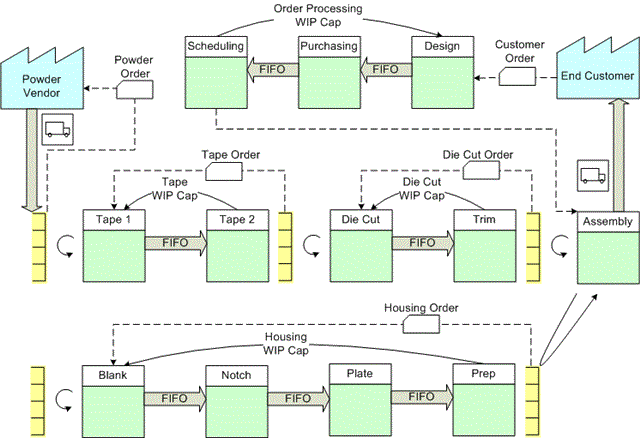WIP
Cap Pull Systems
This eBook gets into the
nitty-gritty details of how to
implement and continuously improve
my favorite Pull Scheduling
System! I'll walk you through a
sequential process that will help
you get a powerful system up and
running in no time. This
eBook also works as a guide
to implementing other
work-in-process pull systems such
as Capped FIFO Lanes, Drum Buffer
Rope (DBR), and Simplified Drum
Buffer Rope (S-DBR).
WIP Caps are easy to implement,
easy to operate, and provide a
level of performance and
flexibility that is hard to beat
in many applications.
Note - If you are unfamiliar with
WIP Cap Pull Systems, please read
my Pull Scheduling Systems
Overview first. The overview
reviews the basics of Pull Systems
and helps you
understand where they are,
and are not, appropriate.
To
get this eBook, simply add to
your cart and complete
the checkout process. The
eBook will then be emailed
directly to you.
$29.95 WIP Cap Pull Systems
The
following is a preview from the
eBook:
II. Where are
WIP Caps Appropriate?
This
chapter gets us started on
determining where to use WIP
Caps and how to establish their
initial boundaries.
Where
Should WIP Caps be Used (and
Not Used)
Appendix A shows
a comparison of Pull Methods.
This table is a good starting
point when you are selecting an
appropriate Pull System for a
particular application.
I generally look
towards WIP Caps first in any
application where there is a
Product, a Customer, and
multiple Resources are necessary
to complete a Customer Order.
WIP Cap Pull Systems require:
1.
A
defined family of products that
are routed through the system.
2.
A common
Unit of Measure within the
system.
3.
An easy
method to relay WIP Cap
Authorization information from
the last Process back to the
first Process.
4.
The
Lead-Time through the system
supports the Customer’s desired
Lead-Time.
5.
Some
variation in the In-Box quantity
at each Process can be tolerated
(primarily related to the
physical space that the products
require).
It is usually
desirable (but not absolutely
necessary) that:
·
The
processes are sequenced such
that products follow a FIFO flow
between Work Centers.
·
Resources,
such as people, machines,
space, etc, are dedicated
exclusively to the defined
family of products in the WIP
Cap.
If one or more of
the listed requirements cannot
be met, the use of a WIP Cap
Pull System is not possible. The
following are some examples
where WIP Caps may not be used:
·
One or
more Processes require choices
such as different part numbers,
variations, sizes, etc. A
typical example is at an
Assembly Process.

Figure 3
In Figure 3,
there are three Assembly
Processes within a WIP Cap.
However, the Housing Process is
not part of the WIP Cap because
there are several different
housing part numbers that
Assembly needs to choose from
depending on the Customer Order.
In this case, Assy 1 and Housing
are connected by a Supermarket
Replenishment Pull System.
·
The
customers required Lead-Time
limits the number of processes
than can be included in the WIP
Cap. Let’s say that in the
example in Figure 3 that all
assemblies use the same housing.
However, if each Process in this
example takes 1 day, and the
customer wants a 3 day
Lead-Time, the Housing Process
cannot be included in the WIP
Cap. The Supermarket between
Housing and Assy 1 assures that
there is always a supply of
Housings, and that the Customer
Lead-Time is 3 days.
·
The Unit
of Measure changes part way
through the Value Stream.

Figure 4
In Figure 4, the
Unit of Measure on Customer
Orders is “each” whereas Unit of
Measure on the Tape Orders is
“rolls”. Even though the same
rolls are used for all finished
part numbers, the WIP Cap cannot
extend between Tape 2 and Die
Cut because the Unit of Measure
changes.
·
The
layout of an assembly line does
not allow for variable In-Box
sizes. This is often the case
where the layout has been
designed around minimizing
material handling for repetitive
manufacturing of the same or
similarly sized products. In
this case, a Capped FIFO Lane is
used instead of a WIP Cap. Note
– If a little flexibility is
designed into the physical
layout, a WIP Cap can usually be
accommodated.
WIP Caps, and
Pull Systems in general, are not
just for manufacturing
operations. Any system that
includes a Product, multiple
Resources, and a Customer Order
will benefit from the
application of a WIP Cap. Some
examples where I have seen WIP
Caps effectively applied
include:
·
Shop
floor manufacturing operations.
·
Customer
order processing through an
office.
·
New
product development.
·
Insurance
claims processing.
·
Company
wide continuous improvement
initiatives.
The essence of
Lean Manufacturing is to only
work on a few things at a time,
complete them quickly, then move
on to the next thing. WIP Caps
force this behavior. They also
maximize current Throughput and
future improvement by clearly
highlighting the current
Constraint in any system. The
point here is to not limit your
thinking on where these systems
can be applied.
The following
example shows a company wide
Value Stream map with a host of
WIP Cap Pull Systems.

Figure 5
To
get the entire eBook, simply
add to your cart and complete
the checkout process. The
eBook will then be emailed
directly to you.
$29.95 WIP Cap Pull Systems